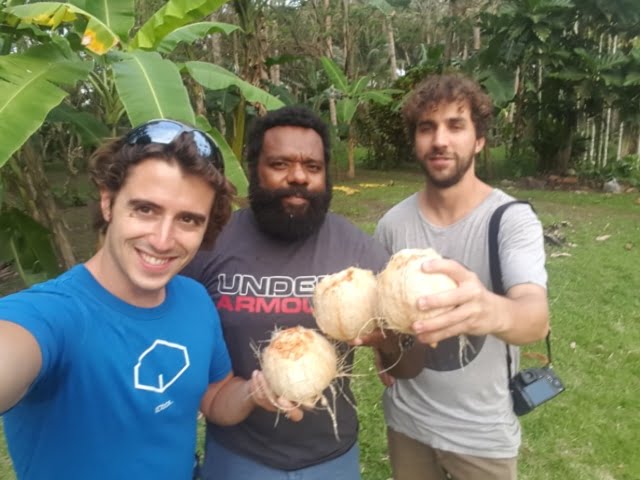The idea of drones flying around autonomously, controlled by artificial intelligence, would have sounded like something out of a sci-fi movie ten years ago. Today, it’s not only a viable possibility, but it’s a working solution to some of the time-consuming tasks faced by farmers in developing countries.
Today, this groundbreaking Proof of Concept (PoC) is led by tech entrepreneur and London Blockchain Week hackathon winner Julien Bouteloup, who traveled to the remote village of Kokopo last year to conduct the first trial for Flyingcarpet, a solar and AI-powered drone solution for farmers.
The First Trial
Namaliu, a coconut farmer in Papua New Guinea, was the first person in the Pacific to put Flyingcarpet’s solar-powered drones to the test. The drones, using AI, are able to collect vast amounts of data within minutes.
The autonomous drone successfully analyzed a section of Namaliu’s 100 hectare coconut plantation, using high-definition cameras to count the exact number of coconuts growing in the fields. This information would normally take workers days of surveying to complete.
“There are huge advantages to being able to count the number of coconuts this way. You can better understand and estimate the return on your crop harvesting, as well as prevent coconuts from being stolen,” said the coconut farmer.
“Namaliu, Jr. was amazed that this small device could capture all this video data from his coconut trees and show him how many coconuts there were,” added Bouteloup.
Built by Bouteloup himself, the Flyingcarpet device is a solar-paneled charging and docking station which drones can use as a base. Drones connect to Flyingcarpet’s decentralized, blockchain-based Air Network. Each Flyingcarpet drone is ‘trained’ to perform certain tasks independent of human interaction or control, in this instance helping Namaliu increase the efficiency of his farming practice with the option of selling data about coconut production to a decentralized data marketplace.
Helping Global Communities
Though successful, Bouteloup believes this Proof of Concept exercise demonstrates only a fraction of the potential that drones powered by AI and blockchain technology have for communities like Namaliu’s.
“This advanced technology can improve the lives for people in emerging communities all around the world, if only we know how to harness it the right way,” says Bouteloup.
A report produced by the Asian Development bank has found that while farming employs more people in developing nations than any other industry, there is little innovation within the sector. Bouteloup, who has degrees in electrical engineering and machine learning, came up with the idea for Flyingcarpet during his travels to more than 20 countries.
“These communities do not even have access to smartphones or the internet, but I knew we could easily provide them with the latest technologies to add immeasurable value to their daily lives and work,” he said.
One of the obstacles Flyingcarpet faces is gaining adoption in developing communities. Bouteloup shares their plan, “We will be conducting a range of PoCs globally and working with different governments, NGOs and corporate partners to help implement these services widely. Ultimately, this is about incentives and showing people how they can benefit from this resource.”
Why Blockchain?
Flyingcarpet-operated drones can automate and perform tasks beyond agricultural productivity. They can deliver vital medicine and water, predict weather patterns, and even provide villages with a steady income stream via the Air Network Protocol.
When asked if Flyingcarpet really needs blockchain technology as a foundation, Bouteloup explains, “Blockchain is critical because it decentralizes access to data, in this case visual data that is collected by drones connected to the Flyingcarpet network. We want to provide people with access to data and enable them to distribute the value of that data to relevant participants in our network, rather than a centralized operator who typically controls all visual data.”
A distributed protocol also adds security, protecting the drone software from bad actors. “If you have all your drones operating within a centralized network protocol, someone could corrupt the data or use the drones for criminal activity. If you decentralize this structure, this can be avoided entirely. Bringing smart contracts into the picture, the drone has to operate using a version of the algorithm that has been hashed into the smart contract and validated by the AI network and other humans validators,” explains Bouteloup.
The Air Network
The Protocol is a decentralized autonomous services network enabling anyone to deploy their IoT devices, such as drones with high-definition cameras, to carry out requested tasks through the Flyingcarpet App.
Villages can own both a drone and Flyingcarpet charging station connected to the Air Network and receive payment when either device is ‘rented’ by individuals or businesses through the startup’s app.
Ambitious Goals
Viktor Tron, who was one of the first employees of the Ethereum Foundation and the lead developer of Swarm, is Flyingcarpet’s first advisor. He and Bouteloup are working together toward a “common vision” of decentralizing supply chain economies.
“Drones are the future, and [this] project offers a decentralized solution to industries like agriculture and infrastructure. Julien is a passionate and dedicated entrepreneur, and I believe he is the most capable person in the field to bring this project to scale,” said Tron.
Last year, Bouteloup released a pilot of his winning LBW hackathon project, IDbox, a small and cost-efficient device that enables people in developing countries to create a unique identity, which they can use to access voting systems, remittance services, health care, and renewable grid electricity — all via an analog phone. As to Flyingcarpet’s success, the results of growing this AI drone community sound exciting but remain a work in progress for now.
*
PHOTO: Flyingcarpet founder and CEO Julien Bouteloup (left), coconut farmer Namaliu Jr. (center), and Ben Jackson of Abt Associates (right).

